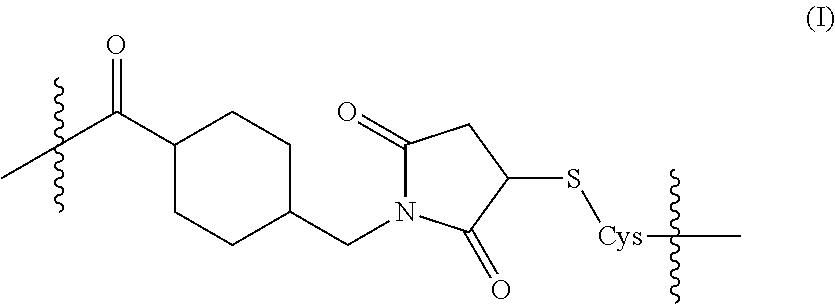Immunogenic peptide conjugate and method for inducing an anti-influenza therapeutic antibody response therewith
a technology of immunogenic influenza and conjugates, which is applied in the field of immunogenic influenza hemagglutinin a2 (ha2)derived peptide conjugates, can solve the problems of post-flu pneumonia and other lethal complications of persons with chronic medical conditions, and achieve the effect of potent antiviral properties
- Summary
- Abstract
- Description
- Claims
- Application Information
AI Technical Summary
Benefits of technology
Problems solved by technology
Method used
Image
Examples
example 1
Preparation of a Hemagglutinin FIR Peptide-KLH Conjugate
[0067]The FIR peptide of SEQ ID NO: 1 was synthesized with an added N-terminal Cys linking residue; i.e., to produce the peptide of SEQ ID NO: 19, which was then conjugated with KLH using the SMCC method. Briefly, the carrier KLH protein first was activated by reacting SMCC with one or more primary amine groups (e.g., on a lysine residue of the carrier protein). The resulting activated carrier was then separated from any excess SMCC and by-product therefrom. The cysteine-derivatized FIR peptide then was reacted with activated KLH; the sulfhydryl (thiol) group of the cysteine adding across the double bond of the maleimide moiety of the SMCC-derivatized carrier protein, thus forming a covalent sulfide bond. The resulting FIR peptide-KLH conjugate was then isolated.
example 2
Production of Mouse Monoclonal Anti-FIR Peptide Antibody
[0068]Five Balb / C mice were injected with the conjugate as prepared in Example 1. The first injection utilized the FIR peptide-KLH conjugate mixed with complete Freund's adjuvant on day 0. On days 21, 35, 49, and 63 the mice were injected with the FIR-peptide-KLH conjugate in incomplete Freund's adjuvant. Serum samples were collected from the mice on days 45, 59, and 73, and tested for the presence of anti-FIR peptide antibodies using an ELISA method with the FIR peptide (SEQ ID NO: 1) passively bound to the wells of 96-well plastic plates. Three mice with the highest titer of anti-FIR antibodies were sacrificed and the spleens were harvested. Using standard techniques, splenocytes were harvested and fused with sp2 / 0 cells, and hybridomas producing anti-FIR antibodies were identified by ELISA and subcloned by limiting dilution. Several clones were identified and one designated MAF3-2, was used in further analysis.
example 3
Production of Therapeutic Anti-FIR Peptide Antibody in Goats
[0069]A goat was injected with the conjugate as prepared in Example 1. The first injection was with 500 μg of the FIR peptide-KLH conjugate in complete Freund's adjuvant. Subsequent injections, at two-week intervals, were with 250 μg doses of the conjugate in incomplete Freund's adjuvant. After a total of three injections, a serum sample was prepared at week 5 after the first injection. The serum sample was found to contain a detectable titer to the FIR peptide in a plate ELISA test.
[0070]The goat was injected once more with 250 μg of the FIR peptide-KLH and sera samples were prepared at weeks 7 and 8. The serum samples from weeks 7 and 8 were titrated for their reactivity to the FIR peptide (SEQ ID NO: 1) with a plate ELISA assay. The plates were coated with non-conjugated FIR peptide and antibodies in the serum samples were found to specifically bind to the coated plate.
PUM
| Property | Measurement | Unit |
|---|---|---|
| concentration | aaaaa | aaaaa |
| volume | aaaaa | aaaaa |
| temperature | aaaaa | aaaaa |
Abstract
Description
Claims
Application Information
 Login to View More
Login to View More - R&D
- Intellectual Property
- Life Sciences
- Materials
- Tech Scout
- Unparalleled Data Quality
- Higher Quality Content
- 60% Fewer Hallucinations
Browse by: Latest US Patents, China's latest patents, Technical Efficacy Thesaurus, Application Domain, Technology Topic, Popular Technical Reports.
© 2025 PatSnap. All rights reserved.Legal|Privacy policy|Modern Slavery Act Transparency Statement|Sitemap|About US| Contact US: help@patsnap.com



